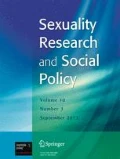Abstract
The diversity of South Africa’s prostitution industry exposes sex workers to varying levels of violence. The street, truck stop, hotel, agency, brothel, and dockside trades are characterized by different structural features that determine the prevalence of client, police, and third-party abuse against prostitutes. Comparing the structural elements of each sector allows not only gauging the likelihood of violence within a given niche but also devising more precise policy instruments to reduce violence at an industry-wide level. This article focuses on the dockside prostitution sector, showing how its structural features enhance the women’s power vis-à-vis their clients and discussing 5 key variables that influence the likelihood of violence: the social and legal status of the client, the location of the negotiation, the location of the sexual act, the level of discretion in the solicitation process, and the role of third-party involvement. Detailed policy recommendations conclude the argument.
Similar content being viewed by others
References
Abrahams, N., Jewkes, R., & Laubsher, R. (1999). “I do not believe in democracy in the home”: Men’s relationship and abuse of women. Medical Research Council Report, Cape Town. Retrieved November 15, 2006, from http://www.mrc.ac.za/gender/nodemocracy. pdf
Campbell, C. (2000). Selling sex in a time of AIDS: The psycho-social context of condom use by sex workers on a southern African mine. Social Science & Medicine, 50, 479–494.
Clayton. J. (2005, August 12). Where sex crime is “just a bit of a game.” Times Online. Retrieved August 15, 2007, from http://www.timesonline.co.uk/tol/news/ uk/article554402.ece
Delius, P., & Glaser, C. (2002). Sexual socialisation in South Africa: A historical perspective. African Studies, 61, 27–54.
Ekberg, G. (2004). The Swedish law that punishes the purchase of sexual services. Violence Against Women, 10, 1187–1218.
Farley, M. (2004). “Bad for the body, bad for the heart”: Prostitution harms women even if legalized or decriminalized. Violence Against Women, 10, 1087–1125.
Farley, M., & Kelly, V. (2000). Prostitution: A critical review of the medical and social sciences literature. Women & Criminal Justice, 11(4), 29–64.
Fick, N. (2005). Coping with stigma, discrimination and violence: Sex workers talk about their experiences. Sex Workers Education and Advocacy Task Force report, Cape Town. Retrieved January 5, 2007, from http://www.sweat.org.za/docs/coping.pdf
Hunter, M. (2002). The materiality of everyday sex: Thinking beyond “prostitution.” African Studies, 61, 99–120.
Jewkes, R., & Abrahams, N. (2000). Violence against women in South Africa: Rape and sexual coercion. Crime Prevention Resources Centre Report, CSIR, Pretoria.
Jewkes, R., Penn-Kekana, L., Levin, J., Ratsaka, M., & Schrieber, M. (1999). “He must give me money, he mustn’t beat me”: Violence against women in three South African provinces. Medical Research Council Report, Pretoria. Retrieved November 15, 2006, from http://www.mrc.ac.za/gender/violence.pdf
Leclerc-Madlala, S. (2003). Transactional sex and the pursuit of modernity. Social Dynamics, 29(2), 213–233.
Leggett, T. (2001). Rainbow vice: The drugs andsexindustries in the new SouthAfrica. Cape Town, South Africa: David Philip.
Luiz, J. M., & Roets, L. (2000). On prostitution, STDs and the law in South Africa: The state as pimp. Journal of Contemporary African Studies, 18, 21–38.
Marcus, T., Oellermann, K., & Levin, N. (1995). AIDS and the highways: Sex workers and truck drivers in KwaZulu-Natal. Indicator South Africa, 13, 80–84.
Meekers, D. (2000). Going underground and going after women: Trends in sexual risk behaviour among gold miners in South Africa. International Journal of STD & AIDS, 11, 21–26.
Mitchell, C., Smith, A., & Larkin, J. (2001). HIV/AIDS and gender-based violence: Who has the power?: A challenge for school management in South African schools. HIV/AIDS Impact on Education Clearinghouse. Retrieved November 15, 2006, from http://hiv aidsclearinghouse.unesco.org/file download.php/ 498PowerMcGill.pdf?URL ID=1309& filename= 10352886010498PowerMcGill.pdf& filetype= application%2Fpdf& filesize=882102& name= 498PowerMcGill.pdf& location=user-S/
Moffett, H. (2006). “These women, they force us to rape them”: Rape as narrative of social control in postapartheid South Africa. Journal of Southern African Studies, 32, 129–144.
O’Connell, J., & Taylor, J. S. (1996). Child prostitution and sex tourism: South Africa. End Child Prostitution and Trafficking report, Bangkok. Retrieved October 10, 2006, from http://www.ecpat.net/eng/Ecpat inter/ Publication/Other/English/Pdf page/ecpat child prost sex tourism south africa.pdf
Pauw, I., & Brener, L. (2003). “You are just whores—you can’t be raped”: Barriers to safer sex among women street sex workers in Cape Town. Culture, Health & Sexuality, 5, 465–481.
Ramjee, G., & Gouws, E. E. (2002). Prevalence of HIV among truck drivers visiting sex workers in KwaZulu-Natal, SouthAfrica. Sexually Transmitted Diseases, 29, 44–49.
Raymond, J. G. (2004). Prostitution on demand: Legalizing the buyers as sexual consumers. Violence Against Women, 10, 1156–1186.
Sexual Offences Act of 1957. Pretoria, South Africa: Government Printers.
Statistics South Africa. (2000). Quantitative research findings on rape in South Africa. Retrieved July 30, 2007, from http://www.statssa.gov.za/Publications/ Rape/Rape.pdf
Trotter, H. (2007). The women of Durban’s dockside sex industry. In R. Pattman & S. Khan (Eds.), Undressing Durban (pp. 441–452). Durban, SouthAfrica: Madiba Press.
Varga, C. A. (1997). The condom conundrum: Barriers to condom use among commercial sex workers in Durban, South Africa. African Journal of Reproductive Health, 1, 74–88.
Wojcicki, J. M. (2002). “She drank his money”: Survival sex and the problem of violence in taverns in Gauteng Province, South Africa. Medical Anthropology Quarterly, 16, 267–293.
Wojcicki, J. M., & Malala, J. (2001). Condom use, power and HIV/AIDS risk: Sex-workers bargain for survival in Hillbrow/Joubert Park/Berea, Johannesburg. Social Science & Medicine, 53, 99–121.
Wood, K., & Jewkes, R. (1998). “Love is a dangerous thing”: Micro-dynamics of violence in sexual relationships of young people in Umtata. Medical Research Council Report, Pretoria. Retrieved November 15, 2006, from http://www.mrc.ac.za/gender/finallove.pdf
Wood, K., Maforah, F., & Jewkes, R. (1996). Sex, violence and constructions of love among Xhosa adolescents: Putting violence on the sexuality agenda. Medical Research Council Report, Cape Town. Retrieved November 15, 2006, from http://www.mrc.ac.za/ gender/sexviolence.pdf
Woolman, S., & Bishop, M. (2006). State as pimp: Sexual slavery in South Africa. Development Southern Africa, 23, 385–400.
Author information
Authors and Affiliations
Corresponding author
Rights and permissions
About this article
Cite this article
Trotter, H. Navigating risk: Lessons from the dockside sex trade for reducing violence in South Africa’s prostitution industry. Sex Res Soc Policy 4, 106 (2007). https://doi.org/10.1525/srsp.2007.4.4.106
DOI: https://doi.org/10.1525/srsp.2007.4.4.106


